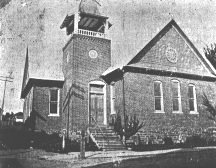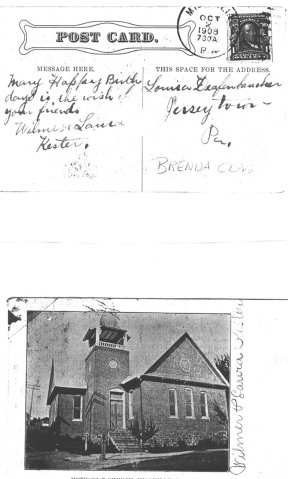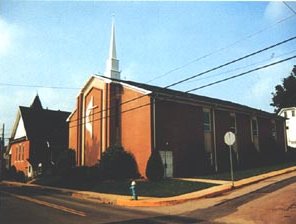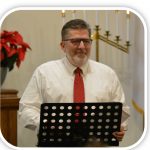
The sanctuary was dedicated November 14, 1897. The fund drive started under the direction of Reverend Henry A. Straub, was completed under the ministry of Reverend David Y. Brouse who served the circuit from March 23, 1897 to April 2, 1902. The total cost of the brick structure was $3,500. In 1902 a large bell was placed in the belfry as a gift from Mr. L. P. Kline, a devoted layman of the church.
The church basement was excavated, cemented, and equipped in 1913 for use as a social room and kitchen at a cost of $42,600. By that time, the church membership had grown to 96. New pews and carpet were installed in 1928.
Prior to 1940, the women of the church worked through the Ladies Aid Society. 1942 was a busy year in the life of our church. Sixty-five hymnals were purchased for the sanctuary. Of course, 1942 saw many of our borough’s fine young men leaving for war. Our church, along with the other churches of the boro purchased and distributed a booklet entitled “Strength for Service to God and Country” to each serviceman before he departed. The church basement was designated as a first aid center in case of an air raid. Our church’s first choir was also established in 1942, under the direction of Reverend Kerstetter and a new Coal furnace was purchased at the cost of $525.00.
In the 1930’s to the 1950’s, the Men’s Bible Class met in the old church basement, usually with 35 – 40 men present. In those days the Sunday School Class met not only on Sunday mornings, but they also had monthly programs as well. They combined with the ladies after 1960.
Food seemed to be a major source of income for the Women’s Society of Christian Service (WSCS) in the 1940’s. Three hundred dozen donuts were sold in one day, case after case of peanut crunch & mints were sold and very profitable bake sales were held, after much organization to procure sugar, which was in short supply during the war.
An education unit consisting of children’s classrooms was added to the back of the church in 1942 while Reverend Earl Kerstetter was pastor This was the first addition to the original brick building. The value of the building, grounds, and the furnishings was listed at $15,000.
During July of 1943 the church was struck by lightning, fortunately resulting in only minor damage. November 23, 1947 the 50 year anniversary of the construction of the original church building was observed. In December of 1947 plans were approved for a Young People’s room to be created between the Primary Department and the main auditorium. Cost of this project was $1,500. In April 1948 the building was appraised at a value of $24,500 and the fixtures at $2,500.
Sometime prior to 1949 a gentleman presented a pr ogram for the congregation that involved creating a chalk drawing of the head of Christ while giving an inspirational message and donated it to the church. It hung in the sanctuary for many years and now hangs in the narthex. Take a moment to study it sometime – it is really a work of art.
During the 1940’s the six point charge was expanded to eight points with the addition of Ikelers and Pine Center. From that time until 1955, when those two churches were included in the Millville -Jerseytown charge, there was an assistant pastor for the eight points – the two mentioned already and Millville, Jerseytown, Iola, Pine Summit, Eyers Grove and Greenwood. Later Millville and Greenwood became one assignment and Jerseytown, Eyers Grove, Iola, and Pine Summit a different charge of the Sunbury District of the Central Pennsylvania Conference of the Methodist Church. At this time the Millville/Greenwood charge purchased the original parsonage at public auction.
During November 1950 the men of the church dug out the rear basement, disposed of the coal furnace and a new cement floor was poured. A new oil furnace was installed. This renovation cost $2,500. The operating budget for 1952 was $3,200. In April 1952 maroon colored choir chairs were ordered. May 1954 the Trustees authorized the purchase of the DeMott property at the corner of State & Walnut streets for $6,600 which then became the church parsonage in June 1955. Prior to that, the parsonage was the house at the end of the CCFNB drive.
In May of 1953, Mr. Luther Baker and his daughter Barbara offered ornamental plantings along with annual care for the front of the church in memory of Mrs. Enza Baker, his wife and Barbara’s mother.
The Junior Choir was organized in 1954 under the direction of Mrs. Jane Wright and Mrs. Betty Deaner. Since that time, many young people have lifted their voices in song. Jane continues to work with the choirs to this date.
Alterations to the church sanctuary were approved in February 1955 and included removal of the post behind the pulpit and the placement of a steel beam overhead. Windows behind the pulpit were filled in and painted over, walls were painted, the choir floor was extended, new choir pews were made and installed and new lighting fixtures hung. Mr. Herman Kauffman was commissioned to build a communion table, pulpit and lectern. Parsonage renovations in 1956 brought removal of the outhouse, installation of kitchen cabinets, new bath fixtures and wiring. Various furnishings, including a dinette set donated by the Youth Fellowship, were purchased in 1956 and 1957.
In 1953 a very active WSCS voted to be responsible for the furnishings in the parsonage. In 1958 this same group planned a full slate of events for the year: September – Auction, October – Cookie Sale, November – Soup Sale, December- Bake Sale, January – Sauerkraut Supper, February – Doughnut Day, March – Birthday Tea, April – Cookie Bake, May – Progressive Supper, June – Ice Cream Social. The annual dues of the ladies of this organization at the time was $3.00 per year. Ice cream at the ice cream social in June sold for 75 cents a quart.
In 1958 a donation of funds to purchase an organ for the sanctuary was received by Esther Derr and family, and a Baldwin Organ was purchased in memory of Jay C. Derr. Shortly after the Young Adult Class purchased the organ chimes which are still used with the current organ. In April of 1959, Mr. Don Kaler was commissioned to design and build an altar rail for use on Communion Sundays.
Mr. Wallace Eves sold his property at the northeast corner of the church property to the church for $1,000 in February of 1959. A parking lot, with the capacity to hold 15-20 cars in the rear of the church and parsonage, was finished. This parking lot was blacktopped in1970.
Missions have always been a large part of the church’s outreach. In 1962 the children contributed special offerings to be used to send books written in Spanish to South America. Health kits were sent to Korea as part of the missions projects. Mittens and socks were sent to the Church of All Nations in New York City. In 1967 Christmas boxes were packed and sent to our servicemen in Vietnam. Another form of outreach so beautifully demonstrated by the WSCS was their “Ring-A Day” program initiated in 1968. Any older person living alone was called every day if they wanted the service.

For many years Children’s Day in June was looked forward to with great anticipation. The Children’s Sunday School Department and Junior Class would present a program with songs and poems and recitations by the children. Betty Leighow, known to all children in the church, has been involved in the Sunday School for more than fifty years. She has also trained more acolytes than anyone can remember. More recently, the children have been involved in the Heifer Project, as a mission venture. Each spring the children present a play and offerings are collected. These funds then go to the Heifer Project, to purchase an animal for a needy farm family in the United States. In 1996 they collected enough money for two animals. Other mission projects have included mittens and caps collected at Christmas to send to Red Bird Mission and Valentines made and sent to the Veteran’s Hospital in Wilkes-Barre.
Harvest Home celebrations each fall were always a big event. The front of the church would be decorated with corn shucks, pumpkins, donated home canned goods and other items. The platform would be filled with donations that usually went to Mechanicsburg Children’s Home.
In February 1967 all indebtedness was paid off. That year 110 hymnals were purchased and thirty of the old hymnals were sent to the Philippines as a mission project. The parsonage was painted, and 12 tables and 50 chairs were purchased for the Sunday School rooms. In1968 carpet was laid in the Children’s Department at the cost of $757.90. The Methodist Men had 28 original members when they received their charter on February 3, 1967 and hangs now in the “Seekers” Classroom. Today the United Methodist Men sponsor a child from Colombia, South America and Greg Laubach leads a group that answers requests for help. Between 18 and 30 men are active in this beneficial group
In 1968 a plan was proposed by both the Methodist Conference and the Evangelical United Brethren Conference to merge into one denomination. The merger was approved and the United Methodist Conference was established and our congregation became known as the Millville United Methodist Church.
The official church membership numbered 379 in 1969. In 1970 new gold choir robes were purchased. November 11, 1971 the WSCS approved the establishment of a library fund. A committee was named in 1972, and $74.00 was used to purchase books for a church library. In June 1972 the WSCS became United Methodist Women. Remodeling the kitchen was a priority in 1973 and a fund was established. In 1974 the parsonage furniture was sold at auction for $466 76. In November 1976 the UMW approved remodeling plans for the kitchen and voted to be responsible for the $1,359 00 cost of the project.
The United Methodist Women have undertaken many worthwhile mission projects over the years. They participate in pledge drives yearly for UMCOR, contribute to the building fund, contribute to a needy child in this community at Christmas and also send donations to the Methodist Home for Children. The UMW sponsored the anniversary afghan which is a beautiful remembrance of this anniversary celebration. The Caring Circle goes to nursing homes and visits with patients, and the kitchen circle prepares meals for funerals and special occasions. Another outreach the missions committee sponsors each year is Blanket Sunday. Through this Church World Service project blankets are collected and sent around the world. Red Bird Mission holds a special place in this congregation’s heart due to the efforts of Dean and Barbara Evans.
The Young Adult Sunday School Class began a Love Fund project in December, 1972 to provide assistance to those in need in the Millville area. The fund, established with $250.00, still a vital part of the church’s outreach ministry, is now administered by The Thomas Class. During the annual Millville Fireman’s Carnival the Class operates the hot sausage stand with volunteers from the entire congregation. All proceeds from the stand are deposited in the Love Fund. The other adult Sunday School classes, the Seekers and the Senior Adults provide leadership in various church offices and responsibilities.
Another addition, an educational unit was built due to increased Sunday School attendance. Ground was broken on Sunday, October 24, 1975, and by March 6, 1977, the two rooms on two levels had been finished at a cost of $40,000 the area was consecrated. The pastor at that time was Reverend Keith Schmuck.
In the fall of 1983 the Howard and Winnie Welliver Family presented a carillon to the church by in memory of their daughter and sister Roberta. The planning for the present sanctuary and social hall and the remodeling of the former sanctuary for educational purposes began with a study committee appointed in March 1980. Ground breaking was held on September 16, 1984. Membership had grown from 246 in 1951to 310 in 1984. The first Sunday worship was held June 30, 1985. The cost for this project was in excess of $300,000. The official consecration was Sunday, September 22, 1985, with Bishop Felton E. May and District Superintendent Warren L. Baughman, Jr. in attendance. Reverend Charles T. Tressler was pastor at that time and Karl R. Girton was building chairman. Every pew was filled when 243 people attended this celebration.
Somewhere between 1986 and 1989 Jack and Mary Lewis donated the first two octaves of Schulmerich Handballs in honor of their Church Family and their Lay Witness Mission Families. The third octave was purchased in 1993 with Memorial Fund money. Chimes have also been acquired.
In August, 1987 a new sanctuary organ was obtained through a memorial gift given by Virginia Whittington in memory of her parents, Mary Hester Rose and Hay Graham Rose of Florence, South Carolina. An Allen Digital Computer Electronic Organ was chosen.
In April, 1991 the church Trustees approved the purchase of land and hired Harold Fisk as contractor to build a new parsonage. The Parsonage, completed and consecrated on October 13, 1991, cost $105,000.
Youth groups have been active since 1946 when Mr. Jay Derr was Sunday School Superintendent and Reverend Kerstetter was pastor. Mr. Millard Ludwig taught the Senior High class and Mr. Wayne Wright the Junior High class, and they took over the Methodist Youth Group with the assistance of Mr. Wayne Deaner. Christmas carol singing in the streets, followed by refreshments at the home of Paul and Neola Girton, was popular through the 1960’s. Late in the 1950’s people even came from other churches to participate in the youth class activities. On November 1, 1994, Reverend Jim Bramer was hired as Youth Pastor. Since that time our youth, combined with the youth of the Greenwood Congregation, have been involved in many projects and activities.
A preschool program was started in the basement of the church in May 1988 and currently is filled to its capacity of 21 to 23 children. The preschool meets 3 mornings a week and is open to the children of the community. Bible stories, prayer and emphasis on Christian values are part of the every day curriculum and encourages within each child an awareness of the love, the wonder, and the goodness of God.
In 1996 the walkway between the educational building and the church building at the ground floor level was transformed into a magnificent art gallery. This area, under the direction of Ellie Shoemaker, was dedicated October 6. The gallery is a wonderful symbol as it is a connective tissue between the old and the new, which represents life and our faith. This area has become a special place in the building where the children and youth can express their love of Christ through their love of art.
June 21,1996 the property adjacent to the church parking lot was purchased for $80,000. Many members of the congregation, both men and women, spent countless hours during the summer of 1996 working on wiring, plumbing, painting, cleaning, etc. the house which soon became known as Wesley House. After much elbow grease, Reverend Jim and Barbara Bramer moved into Wesley House. In November, 1996 Kreisher Construction began digging out the end of the back yard of Wesley House for construction of a parking lot for our congregation and completed it in April, 1997 at a total cost of $4,700. .The top soil that was removed from the yard was used by the members of the church for their own personal projects
1997 finds the Millville United Methodist Church active and alive with the Good News of Jesus Christ. The current membership numbers 379, and the annual budget stands at $142,000. The Thomas Class sponsors a toy distribution every Christmas for those less fortunate families in the community. This program is the only program of its kind in the Millville area and is an important outreach of the congregation. The church building is open to and used by many community groups, including the Senior Citizens (since 1985), Girl Scouts, Take Pounds Off Sensibly (TOPS), the Millville Women’s Civic Club, Red Cross Blood Mobile and the Little League.
A good percentage of this history has dealt with the many changes to the physical building we call our church, but we must always remember that the church is not a building. THE CHURCH IS ITS PEOPLE and with that in mind, our mission for the next 100 years: ‘This congregation exists for the purpose of worship, learning, service, fellowship and outreach in the name of our Lord, Jesus Christ. We seek to involve all ages in these ministries, from infants, children and youth through senior citizens. It is our mission to hear, to accept, and to follow the Good News of Christ and to share that with all people, whether here at home in our church families and community, or far away in our nation and world.”
Note: Several people contributed to this history for which we are very gratetful. Though this history is correct, we will seek to learn more from the people in our church and records, names will be added for those who have been instrumental in the God’s work from the beginning and continuing into the present.


